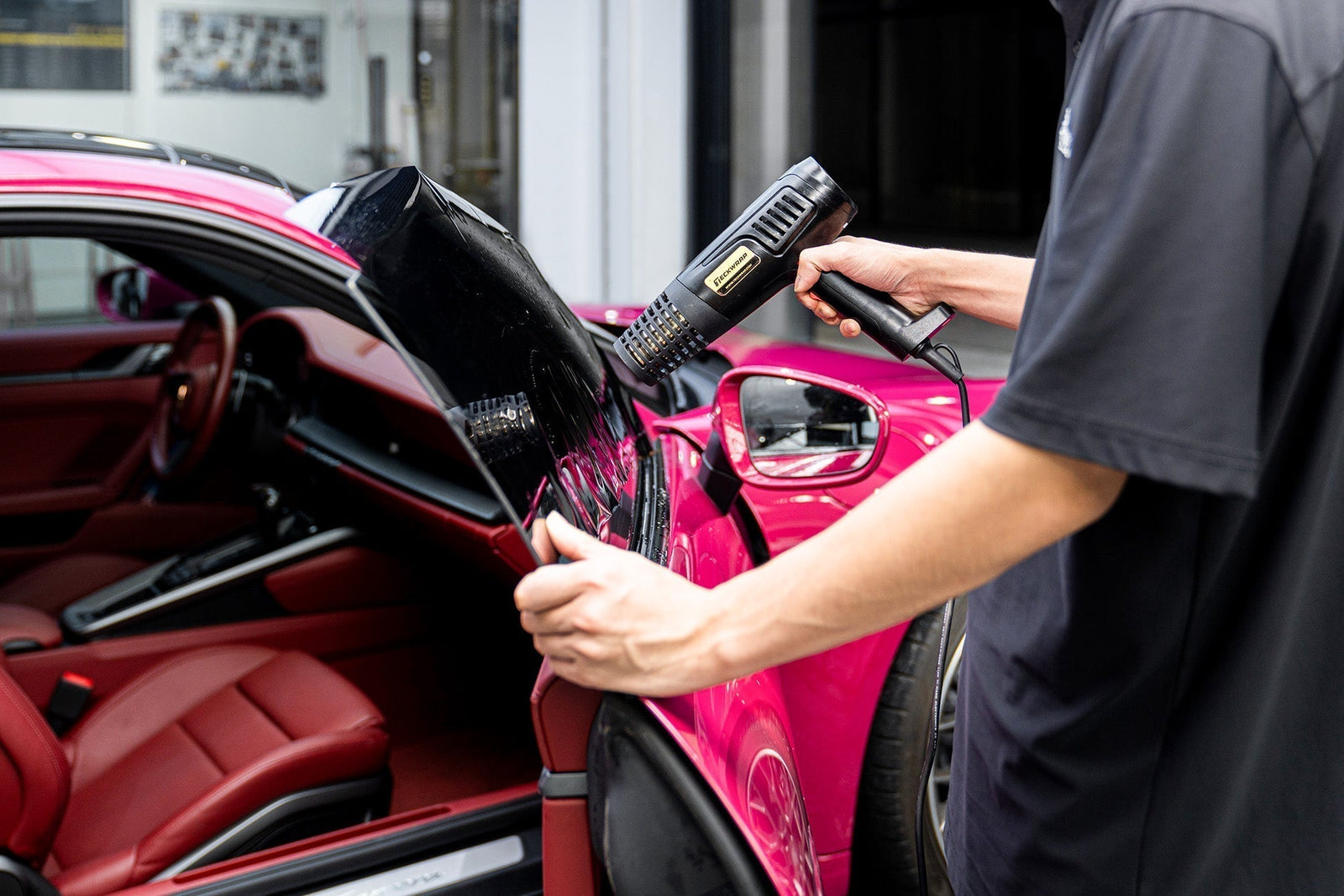Window tints have taken center stage in the vehicle customization market as customers move towards more personalization options. These films, which cover car windows, offer a perfect blend of UV protection and privacy, making them increasingly popular. However, with such a wide variety of car window tints, it can be quite difficult to make an informed decision. To assess the best possible option for your needs, here is a complete guide.
Different Types of Vehicle Window Tints
When you go to buy tints for your ride, you might get overwhelmed with all the options available on the market. The following is a detailed comparative analysis of the different types of window tints and their pros and cons to make the choice easier for you.
Dyed Window Tint
Dyed car tints are made by applying a color-stable dye on a self-adhesive polyester film. This is perhaps the most affordable option out of the rest. It is adhered to the interior surface of the window. It absorbs solar heat and reduces glare by darkening the glass, offering improved privacy and a stylish appearance. It is also the one with the darkest effect, but it tends to fade over time. Hence, it is not the most durable option.
Benefits
- It is the most budget-friendly option among tint types.
- It blocks UV rays, reduces glare, and helps minimize eye strain from bright sunlight.
- Doesn’t interfere with GPS, radio, or phone signals.
Drawbacks
- Less effective at blocking heat compared to other tints.
- The dye can break down with prolonged sun exposure, causing discoloration.
- Doesn’t block as much harmful UV radiation as higher-end tints.
- More likely to peel, bubble, or degrade faster if not properly maintained.
Metalized Car Tint
As the name suggests, this tint has minute metal particles embedded on its surface that help block heat and reduce glare more effectively than dyed films. They give the film a reflective finish and also strengthen the glass slightly, making it more shatter-resistant in case of an accident. It is also scratch-resistant, shields from UV rays, and has great heat rejection. However, the metal flakes might interfere with the GPS and other electronic signals.
Benefits
- Provides excellent heat rejection by reflecting sunlight to keep the car interior cooler.
- More resistant to scratches and fading than dyed films.
- Reduces glare and improves driving comfort in bright conditions.
- Slightly reinforces windows, making them more shatter-resistant.
-
Blocks a significant portion of harmful UV rays.
Drawbacks
- The metal layer can disrupt signals from GPS, radio, cell phones, and keyless entry systems.
- Slightly more expensive than dyed tints, though still cheaper than ceramic.
- Some drivers may not prefer the shiny or mirrored look.
- May not comply with local tint laws due to reflectivity or darkness
Hybrid Window Tint
This is a combination of dyed and metalized components, creating a product that offers superior heat rejection and does not interfere with electronic signals as much. It is made of multiple layers, combining materials from both dyed and metalized films. Its structure generally includes a protective top coat that shields the film from wear and tear; a polyester layer infused with dye; a metalized layer that contains microscopic metallic particles; and lastly, it has an adhesive coating for strong bonding with the glass. It is priced between dyed and ceramic options, making it a good mid-range choice.
Benefits
- Hybrid tint offers better heat rejection.
- It is more durable than dyed films and less prone to fading.
- It provides solid protection against sun damage and improves visibility.
- It is moderately priced.
Drawbacks
- It may still cause very slight interference with electronic signals due to its metallic content.
- While better than dyed or metalized alone, it doesn’t match the top-tier performance of ceramic tints.
- Does not block as much UV radiation as premium films.
Carbon Car Tint
Made up of carbon particles, the long-lasting carbon window tint offers excellent UV protection, heat absorption, and an attractive dark matte finish, which gives the windows of your car a clean, non-reflective appearance. This film is better than dyed or metalized tint film. The carbon particles in the tint block infrared light, helping to keep the car interior cooler without causing signal interference. This film strikes a strong balance between performance, durability, and appearance, making it a popular choice for drivers seeking quality without going fully premium.
Benefits
- Blocks a significant amount of infrared heat, keeping the cabin cooler.
- Doesn’t degrade or discolor over time like dyed films.
- Contains no metal, so it won’t affect GPS, radio, or phone signals.
- Offers a modern, non-glossy look that many drivers prefer.
- Helps protect passengers and interiors from harmful UV rays.
Drawbacks
- More expensive than dyed and metalized films.
- Carbon tint may create glare and haze, reducing visibility for the driver.
Ceramic Car Window Tint
Ceramic tints are the most expensive ones on the market, but that is their only disadvantage. They are made up of ceramic particles and block nearly 99.9% of UVA and UVB rays. They absorb double the amount of heat when compared with dyed films, effectively block out sunlight, reduce glare, and are incredibly durable. They are known for their clarity and high resistance to fading, making them one of the most advanced tint options available.
Benefits
- Blocks up to 99% or more of infrared heat, keeping the interior significantly cooler.
- Rejects over 99% of harmful UV rays, protecting skin and interiors.
- Since it contains no metal, it doesn’t disrupt signals from GPS, radio, or mobile devices.
- Offers a clear view from the inside while still reducing glare and maintaining privacy.
-
Long-lasting performance with minimal color change over time. Does not fade or lose its color consistency.
Drawbacks
- This is an expensive tint.
-
The high cost may not be justified in areas that do not experience high sun exposure.
Comparative Performance of Different Vehicle Window Tint Films

|
Tint Type |
Heat Rejection |
UV Protection |
Glare Reduction |
Electronic Signal Interference |
|
Dyed |
Low IR blocking |
Blocks 50% to 60% of UV rays |
Darker tint reduces glare more |
None |
|
Metalized |
Medium to high IR blocking |
Blocks a significant amount of UV Rays |
High. Reflective layer reduces glare |
Yes. Disrupts electronic signals. |
|
Hybrid |
High IR blocking |
Blocks a significant amount of UV rays |
High. Combines reflective and absorptive properties |
Minimal. Slight interference possible |
|
Carbon |
High. Blocks significant IR and heat |
Very good. Strong UV defense |
High. Good glare reduction |
None |
|
Ceramic |
Very high. Up to 99% IR rejection |
Excellent. Blocks 99.9% of UV rays |
Top-tier glare reduction |
None |
Understanding Visible Light Transmission (VLT)
Another important component of window tints is the VLT percentage they offer. VLT or Visible Light Transmission refers to the percentage of light allowed to pass through the window. For example, a 5% VLT, also known as ‘Limousine Tint’, is very dark, blocking 95% of light, while a 70% VLT is quite light, allowing 70% of light to pass through. A darker tint looks good as it gives your vehicle a more refined, confident appearance. It creates a contrast against paintwork, making your ride distinctive without being too flashy. But you cannot have any darkness level that you like.
The legality of the tint, which limits its darkness and reflectivity, is an important factor that must be taken into account. Certain laws have been put in place regarding VLT percentages that vary by state and region, and often by the placement of the window (windshield, front side, and rear side). 50% VLT and upwards is legal in most states. For example, California mandates at least 70% VLT on front side windows, whereas Texas allows as low as 25%. Rear windows often have more lenient or no restrictions. Installing a tint that violates local VLT laws can result in fines, failed vehicle inspections, or mandatory removal, making it necessary to check regulations in your area before choosing a tint level.
Which Car Window Tint is the Best?
Ceramic tints are the best. If you do not have any budgetary constraints and you want excellent UV protection, privacy, and heat reduction without any interference with GPS and other signals, then go for the ceramic tint. They give long-lasting performance and maintain their clarity and color over time, keeping your vehicle looking sharp and well-maintained without fading or bubbling.
If you cannot spend much, then dyed window tint is the most affordable way to achieve a darker look and basic privacy. These tints, however, may not be as durable. Increase your budget a bit more and go for carbon films instead, as they provide the perfect balance between good heat rejection, superior UV protection, durability, and no electronic interference, making them a highly practical choice. You may also consider hybrid films if you want a bit of everything without excelling in any one area and being too pricey.
Choose the Right Film!
When purchasing window tints, it all comes down to your budget, preferences, and the features you are looking for in a film. For premium-quality car tints in different VLT percentages, visit the Teckwrap online store now. Regardless of the type or darkness level, one thing is for certain: window tints instantly transform ordinary vehicles into showstoppers, setting them apart, so grab yours now!

